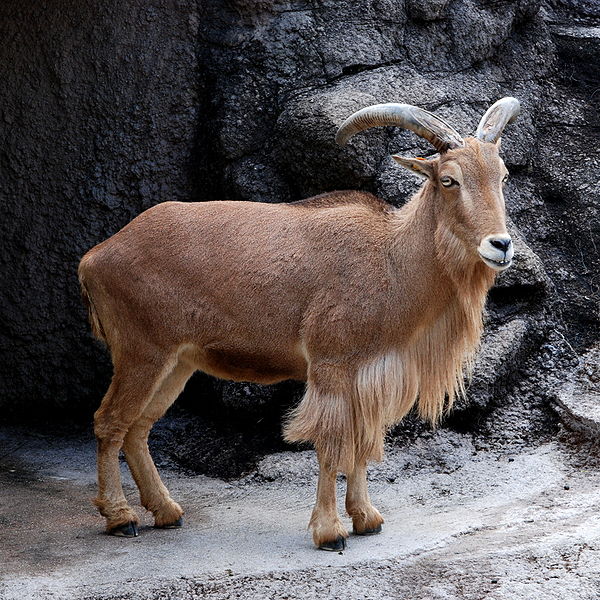Ammotragus lervia
Barbary Sheep
Synonym(s):
Class: Mammalia
Order: Artiodactyla
Family: Bovidae

Photographer: Kuribo
Source: http://en.wikipedia.org/wiki/File:Barbary_Sheep_Tennoji.jpg
Description
Barbary sheep (Ammotragus lervia) also called aoudad sheep are relatively large sheep native to the dry mountains of Northern Africa. Within the U.S. they occupy the same habitats as native big horn sheep and compete with them for resources. Both male and female Barbary sheep have large horns that are located near each other on the back of the head, extend posteriorly and curve in slightly. Female Barbary sheep have slightly smaller horns than males. As adults mature, the horns become a darker shade of yellow/brown. Adults have long tails, reaching to the hocks, with thick hair extending off the tip and lower half. Long hair that is lighter than the rest of the body grows from the chest down to the front of legs. Adult males weigh as much as 145 kg and adult females weigh 65 kg.
Ecological Threat: Barbary sheep are a threat to mule deer and bighorn sheep because of direct competition for food and habitat resources. Mule deer and Barbary sheep feed on similar vegetation and mule deer risk being outcompeted by the aggressive invasive Barbary sheep. Efforts to reintroduce big horn sheep populations are at risk because of habitat competition. Barbary sheep are known to be aggressive and territorial with the ability to climb and evade predators successfully. They also live in packs comprised of mature and immature members allowing a pack size advantage over the native bighorn sheep. Barbary sheep are a threat to wheat farmers with several observations of the invasive sheep feeding on winter wheat crops. They are not currently considered significant agriculture pests.
Biology: Barbary sheep have a relatively long breeding season, with the highest abundance of breeding occurring from September to November. Gestation lasts approximately 160 days with the majority of lambs born from February to April, but some as late as November. By 8 months of age females are sexually mature and by 19 months all females will have given birth.
History: In the 1900's Barbary sheep were introduced to the U.S. and kept on private land and zoos to the present day. Populations were released into the wild in the 1950's and increased in number to the point of hunting permits made available in 1963 to control the population.
U.S. Habitat: Barbary sheep prefer dry and barren habitats with large rocks or mountains to climb and hide in. Similar to the native big horn sheep, Barbary sheep are found in the arid mountains of the southwest United States allowing for competition between the two species for the same habitat.
Distribution
Native Origin: Northern Africa
U.S. Present: CA, NM, TX
Management
The only management method currently employed is hunting by permit only to control populations of Barbary sheep. As with any wild game hunting is by permit only with a controlled number of permits released as decided by parks and wildlife officials based on damage caused by the Barbary sheep. This technique has been used since 1963 in the southwest United States.
How you can help: More information about hunting permits for Barbary sheep in New Mexico
References
Haas, G. 1990. Barbary sheep (Genus Ammotragus). In Grzimek's Encyclopedia of Mammals. Edited by S. P. Parker. New York: McGraw-Hill. Volume 5, pp. 538-540.
Shackleton, D. M. [Editor] and the IUCN/SSC Caprinae Specialist Group. 1997. Wild Sheep and Goats and their Relatives. Status Survey and Action Plan for Caprinae. IUCN: Gland, Switzerland and Cambridge, UK.
Internet Sources
 Texas Invasive Species Institute
Texas Invasive Species Institute